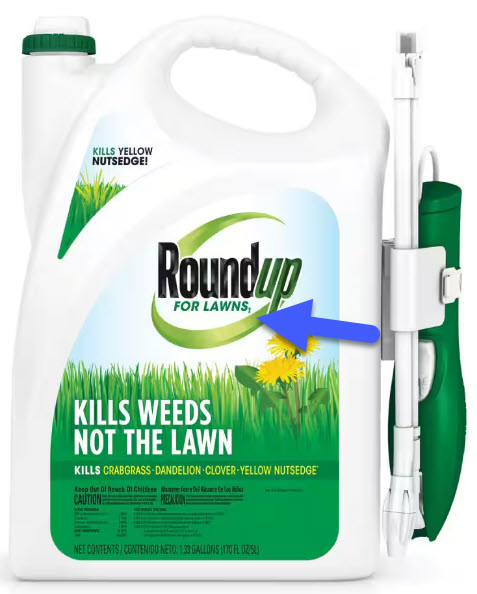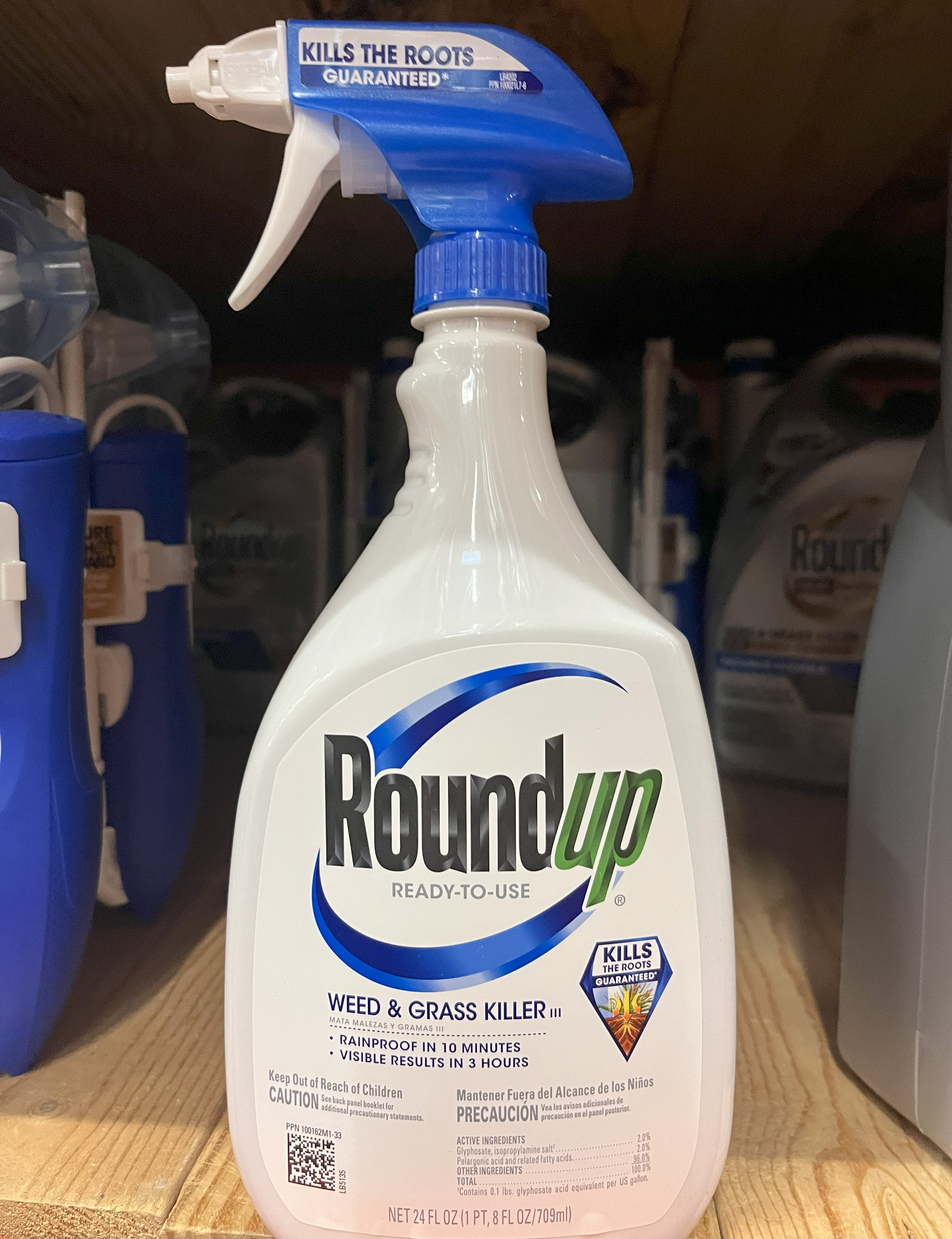Not your mother’s Roundup
The ingredients in Roundup branded products have changed. What does that mean for you?

Note, this information is not meant to supersede the pesticide label. The label is the law, and you are responsible for reading it and following those directions.
Roundup is a branded line of herbicides produced by Bayer, formerly Monsanto. The original Roundup was released in 1974 and contained only the active ingredient glyphosate (pronounced: glai-FOE-sayt). Recently, Bayer has removed glyphosate from all its products intended for residential use. However, the product names remain the same and the bottles are virtually unchanged, which can lead to serious confusion among consumers.
It is always important to read the label of any pesticide prior to purchase and use. Because of these changes in active ingredients, it is particularly important to read the full label of any Roundup product. Pay special attention to the areas where the herbicide is permitted to be used and any restrictions on replanting.
Not all Roundup products are equal. The best way to stay current on changes regarding this brand is to visit their website, Roundup.com. Some important distinctions on currently available products are outlined below and in Table 1, all of which are reinforced by reading and following labeled instructions on the physical product you have or are about to purchase.
Currently available products
Roundup Weed and Grass Killer Exclusive Formula. This product typically has a blue lid. In 2024, we started seeing the “Exclusive Formula” on the market in the Lansing, Michigan, area and on the Roundup.com website (Figure 1). While previous versions contained glyphosate and sometimes pelargonic acid, the new version does not have either active ingredient. The package of the new product is nearly identical to the old packaging but contains a red bar with “Exclusive Formula” printed (Figure 1). The active ingredients now are triclopyr, fluazifop and diquat. Triclopyr has activity on broadleaf (i.e., dicot) plants only. Fluazifop has activity only on grass and grass-like species (i.e., monocots). Diquat will act on any plant species and offers the “instant gratification” burn to show the product is working. This product is NOT labeled for use in vegetable or other edible gardens, even as a burndown application (i.e., application before planting to remove vegetation). The wait time to replant the area treated is no longer “once the product has dried,” as it was with the earlier products. Please refer to the label for details.
Roundup Weed and Grass Killer Super Concentrate Exclusive Formula. This product has a red lid and, like the previously mentioned product, the red bar to indicate that it is the Exclusive Formula. It contains the same active ingredients as the Roundup Weed and Grass Killer listed above, but at a higher concentration, thus requiring mixing with water to achieve appropriate application rates. If you are doing a lot of spraying and do not mind mixing, concentrate products are often the more economical choice.
Roundup Poison Ivy Plus Tough Brush Killer Exclusive Formula. This product, with a yellow or sometimes black lid, contains a blue bar stating Exclusive Formula. It is the exact same product (i.e., active ingredients, concentrations, EPA number) as the 2025 Roundup Weed and Grass Killer Exclusive Formula listed above (Figure 2). It should not be used in lawns or edible gardens.

Roundup Dual Action Weed and Grass Killer Plus 4 Month Exclusive Formula. This product contains the same active ingredients and concentrations as Roundup Weed and Grass Killer Exclusive Formula but adds imazapic for longer lasting activity. This is only appropriate for long-term barren areas, namely concrete crevices, gravel areas, parking areas, etc. (see label for full details). It should not be used in lawns or edible gardens.
Roundup Dual Action 365 Plus 12 Month Preventer Exclusive Formula. This product contains the same active ingredients as the 4 Month version listed above, but the level of imazapic is increased. This is also only appropriate for long-term barren areas. The difference is that this product requires extreme caution to avoid the root zones of trees, shrubs and other desirable plants. With the increased rate of imazapic in this product, it can move through the soil and be taken up by roots, causing injury or death of the plants. Root zones of trees and shrubs often extend well past the drip line of the plant (i.e., the outer edge of the tree/shrub canopy).
Roundup for Lawns. This line of products was launched in 2017 and never contained glyphosate. It is a mixture of several active ingredients aimed at treating the most common broadleaf weeds, sedges, crabgrass and the annual foxtail grasses found in lawns. This will not kill most perennial grassy weeds (e.g., tall fescue). Note, there are a few versions of Roundup for Lawns, some for use in the northern parts of the U.S., like Michigan, where primarily cool-season grasses are used for turf (e.g., Kentucky bluegrass, fine fescues and perennial ryegrass). Others are for use in the southern parts of the U.S., where there are primarily warm-season grasses (e.g., bermudagrass, centipedegrass and bahiagrass).
How do you tell them apart? Hopefully the store you are at has a geographically appropriate formulation, but to verify or when ordering online, look for the small number subscript after the word “lawns” in addition to reading the label (Figure 3).
- 1 = Northern grasses, ready to use formula with attached wand or trigger (refills also available)
- 2 = Northern grasses, concentrate
- 3 = Northern grasses, ready to spray from hose
- 4 = Southern grasses, ready to use formula with wand (refills also available)
- 5 = Southern grasses, concentrate
- 6 = Southern grasses, ready to spray from hose

Roundup for Lawns Crabgrass Destroyer. This product controls emerged, annual grass weeds in cool-season grass lawns, such as crabgrass. It uses a pigment-inhibiting active ingredient (topramezone) that will bleach the plants initially as it is working. This product will not kill most established perennial grasses. There is a restriction to replanting treated areas (about 28 days); see label for most current details.
Roundup Weed Barrier and Roundup Landscape Weed Preventer (Granules). These products have never had glyphosate in them, but the preemergence herbicide pendimethalin. This herbicide acts only at the point of germination to kill plants emerging from seed and has residual activity for up to six to eight months. It will not kill plants already growing. It can be used in residential landscapes, but not in lawns, edible gardens or anywhere that desirable plants will be grown from seed. This product should also not be left on the foliage of desirable plants as injury can occur. Rainfall or irrigation must occur soon after application to activate the product. People and pets should avoid the area until the product has been watered in and the area has dried.
Table 1. List of Roundup products available in 2025, along with their active ingredients, appropriate treatment areas, and abbreviated restrictions.
|
Product |
Active ingredients |
Cap-Bottle Color |
Treatment areas |
Hazardous to trees?* |
Replant restrictions? |
Re-entry interval |
|---|---|---|---|---|---|---|
|
Roundup Weed & Grass Killer- Exclusive Formula |
Triclopyr, Fluazifop, Diquat |
Blue (RTU)-White Red (Conc)-White |
Flower beds, Around trees, Driveways & walkways, Along fences |
No |
Yes |
When dry |
|
Roundup Poison Ivy Plus Tough Brush Killer- Exclusive Formula |
Triclopyr, Fluazifop, Diquat |
Yellow or Black-White |
Around trees, Along fences, & Residential recreational areas |
No |
Yes |
When dry |
|
Roundup Dual Action Weed & Grass Killer Plus 4 Month |
Triclopyr, Fluazifop, Diquat, Imazapic |
Blue- Gray |
Barren areas- Driveways, sidewalks, patios, along fences, gravel areas |
No, when used as directed |
Yes |
When dry |
|
Roundup Dual Action 365 Plus 12 Month Preventer- Exclusive Formula |
Triclopyr, Fluazifop, Diquat, Imazapic-higher concentration |
Black- Gray |
Barren areas- Driveways, sidewalks, patios, gravel areas |
Yes |
Yes |
When dry |
|
Roundup for Lawns- Northern grasses |
MCPA, Quinclorac, Dicamba, Sulfentrazone |
Green- White |
Cool-season lawns (i.e., Kentucky bluegrass, fine fescue, perennial and tall fescue) |
No |
Yes |
When dry |
|
Roundup for Lawns Crabgrass Destroyer |
Topramezone |
Orange- White |
Cool-season lawns (i.e., Kentucky bluegrass, fine fescue, perennial and tall fescue) |
No |
Yes |
When dry after watering in or rainfall |
|
Roundup Weed Barrier |
Pendimethalin |
Yellow- White pouch |
Around trees, shrubs, perennials, ground covers, ornamental grasses, bulbs, and bedding plants |
No |
Yes |
When dry after watering in or rainfall |
|
Roundup Landscape Weed Preventer |
Pendimethalin |
Green- White pouch |
Around trees, shrubs, perennials, ground covers, ornamental grasses, bulbs, and bedding plants |
No |
Yes |
When dry after watering in or rainfall |
*Note, most herbicides can be hazardous to trees if contact is made with leaves, exposed roots and damaged bark. The designation here indicates if the product is likely to leach through the soil and be absorbed by roots.
Products that may still be around but are no longer being manufactured
Roundup Weed and Grass Killer (not the Exclusive Formula). There were several products with versions of this name (Figure 4). Nearly all of them contain glyphosate and some also contain pelargonic acid or diquat. Pelargonic acid, like previously mentioned with diquat, is not systemic but kills tissue contacted and is not systemic, offering the instant gratification that the product is working.

Roundup Weed and Grass Killer Super Concentrate (not the Exclusive Formula). Prior to 2025, this product with a purple lid could still be found in some stores and was listed on the Roundup.com website. The only active ingredient in this product is glyphosate.
Roundup Poison Ivy Plus Tough Brush Killer (not Exclusive Formula). This product contains glyphosate plus triclopyr. It does not contain the grass herbicide fluazifop like the current version.
Roundup Extended Control Weed and Grass Killer and Roundup Max Control 365. Both products contain glyphosate and imazapic. They also have a contact-type herbicide (pelargonic acid in Extended Control and diquat in Max Control 365). Like the Dual Action products, they are only intended for use in barren areas and can be hazardous to trees and shrubs in the area, particularly the Max Control 365 product because of the increased concentration of imazapic.
Michigan State University Extension does not recommend buying herbicides or any pesticides second-hand (e.g., at estate sales, auctions, etc.). These products may no longer be legal to use and if the bottle was already opened, there is no guarantee the contents match the label. It is best to purchase pesticides from a licensed commercial dealer or retail outlet.
For residential users seeking to use glyphosate, generics are still available at the time this article was published. They are more likely to be found at a store such as Menards or Tractor Supply Company than other large chain stores.
With any herbicide or pesticide purchase, careful planning can make the most efficient use of your time and money while keeping you and the environment safe. Learn more in the article “Avoid herbicide misuse at home, things to know before you buy.”
Reference to commercial products or trade names does not imply endorsement by MSU Extension or bias against those not mentioned.
Thank you to Brent Crain and Lindsey Kerr for reviewing this article.
This work is supported by the Crop Protection and Pest Management Program [grant no 2024-70006-43569] from the USDA National Institute of Food and Agriculture. Any opinions, findings, conclusions, or recommendations expressed in this publication are those of the author(s) and do not necessarily reflect the view of the U.S. Department of Agriculture.



 Print
Print Email
Email




